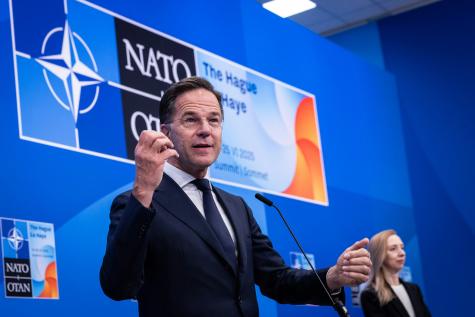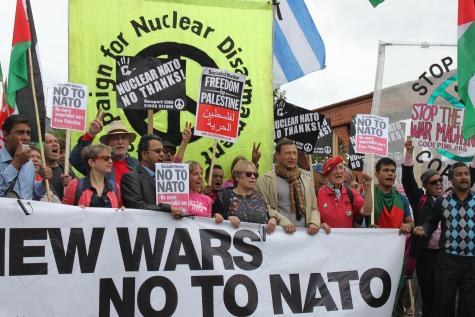NATO

➡️ NATO – Eastern Expansion & Militarisation
The North Atlantic Treaty Organisation was first established in 1949, following the signing of the North Atlantic Treaty. It was founded in the aftermath of World War II to bring together the resources and manpower of multiple Western nations by building a large mutual defence as a deterrent to Soviet Expansion.
The alliance now has 32 member states – 30 in Europe and 2 in North America. The current NATO Secretary General is Mark Rutte.
Jump straight to our guide to ➡️ NATO
Explore our comprehensive guides on -
-
The 5% GDP Goal
-
Nato Eastern Expansion
-
Guides to the Military & Conflict Regions
NATO's 5% Spending Pledge – Pro-War Rearmament
At The Hague Summit in June 2025, all Nato members, with the exception of Spain, agreed to increase their defence spending to 5% of gross domestic product (GDP) by 2035.
The move comes after intense pressure from Trump, who has previously threatened to withdraw from Nato unless other members increase their contributions. He has accused the EU of using the U.S. as a 'security blanket', stating that they take on an unfair financial burden in comparison to the other allies.
This decision represents a massive paradigm shift in national security and budget policies. Even Nato's current 2% target, which many Nato members already fail to meet, is socially and politically controversial.
The increase will be made up of 3.5% of GDP for direct military expenditure and 1.5% for related infrastructure. In 2024, before this increase, Nato spent $1.5 trillion on the military, which equates to more than half of global military spending!!!
In terms of military strength, NATO is already significantly stronger than Russia and China combined.
In 2035, if members comply with the spending goal, the total military expenditure of Nato would reach $13.4 trillion, an incomprehensible amount of money. The 5% goal will leave future generations with insurmountable debt, collapsed social provisions, and a much more dangerous world.

NATO's Eastern Expansion
Critics argue that Nato expansion into Eastern Europe has unnecessarily provoked Russia, heightening tensions and contributing to a new Cold War-like atmosphere, and the Russian Invasion of Ukraine. This expansion is seen as a breach of informal agreements made at the end of the Cold War, especially by Soviet leader Mikhail Gorbachev.
After the collapse of the Soviet Union in 1991, Ukraine declared its independence and began to orient itself more towards the West. Nato first raised the possibility of Ukraine joining at the 2008 Bucharest Summit, which created serious tensions with Russia.
The situation escalated in 2014 when Russia annexed Crimea, leading to an armed conflict in eastern Ukraine. Even before the escalation of the 2022 Russian invasion of Ukraine, both sides were conducting regular military exercises.
Nato expansion has increased the risk of military conflict, especially regarding countries bordering Russia. Many countries see their growth as posturing, an excuse to stockpile weapons, and to involve major powers like the U.S. in regional disputes.
Expansion, especially now with the 5% goal, has diverted resources and attention away from addressing other global security challenges, such as dialogue, conflict resolution, common security, and cyber threats. It has instead shifted the focus onto militarisation.

Military Exercises by NATO
Air Defender 2020 aimed to test the alliance's ability to transport large quantities of troops and tanks on a massive scale across Europe to the Russian border in the shortest possible time.
The Air Defender 2023 was a German-led exercise, marking the largest in NATO's history. The financial and environmental cost of the drill was enormous. It also raised serious questions about the message Nato is sending to the international community.
With the participation of 25 nations and 250 aircraft, the Air Defender 2023 exercise represented a massive mobilisation of military resources. While it is important to prepare for potential attacks and to practice the national and international defence of member states, we should ask ourselves whether such massive military exercises are the right way to promote peace and security.
Steadfast Noon is an annual Nato military training exercise on the handling of nuclear weapons and the procedure in case of nuclear war. The host is always one of the five European nuclear states. Experts estimate that there are around 600 nuclear weapons in Europe in total, including the UK and also around 100 U.S. nuclear warheads that are stored around Europe.
Training covers how to safely transport U.S. nuclear weapons from storage facilities to aircraft and mount them beneath fighter jets. As part of Nato's "nuclear sharing" program, these weapons could be dropped from partner nations' aircraft in an emergency.
Munich Security Conference
This annual gathering usually takes place in February. It brings together Western politicians, military officials, and security chiefs to discuss global defence policy and national security. The conference has repeatedly been criticised by protesters, who see it as a platform for Nato warmongering and further arms buildup. The Munich Peace Conference is a counter-summit that takes place simultaneously, focusing on diplomatic solutions, disarmament, and de-escalation.

NATO – Defence Alliance or Obstacle to Peace?
Since its inception, Nato has continued to expand both its global influence and scope. The alliance has served to destabilise international relationships, including the war in Ukraine, which was provoked by Nato expansion. Their expansion has led to the increasing militarisation of Europe, the Asia-Pacific region and other far-reaching parts of the world.
Nato is also by no means purely defensive. Under the leadership of the U.S., Nato has repeatedly been involved in aggressive conflicts - Kosovo, Afghanistan, and Libya – and is guilty of war crimes.
The dispute between the U.S. and China over Taiwan threatens to spread the influence of Nato even further. To avoid a spiral into World War III, Better World Info advocates for diplomatic and pro-peace solutions that oppose military action and weapons stockpiling.
"I know not with what weapons World War III will be fought, but World War IV will be fought with sticks and stones." - Albert Einstein
Countries spend billions funding Nato at the expense of their own social welfare, the allies have become overly dependent on the U.S. for military support, and Nato is based on the fragile concept of nuclear deterrence!
We must move away from this military madness and create space for a new security policy that relies on conflict resolution, diplomacy and mediation to resolve conflicts in a non-violent and sustainable manner.
Security experts are welcome to share their knowledge and feedback with us.
Author: Rachael Mellor 21.07.25 licensed under CC BY-SA 4.0
For further reading on NATO see below ⬇️
Info on NATO
- General Info[57]
- NATO Summits[542]
- NATO Defense Budget[68]
- 5% GDP Goal - pro war[88]
- Official NATO Pages[5]
- NATO East Expansion[251]
- Anti Russia Campaign[19]
- "Security" Conference in Munich - MSC[73]
- Stop Anders Fogh Rasmussen[9]
- Partnership for 'peace' (?)[5]
- New NATO Doctrin[4]
- NATO Attacks w/o UN Mandate[8]
- Nuclear First Strike[7]
- Media Subversion[3]
- Operation Gladio / Terrorism Involvement[19]
- NATO Disarmament?[14]
- NO to Nato[88]
- Steadfast Defender 2024[18]
- Articles on NATO[222]
- Videos on Nato[24]